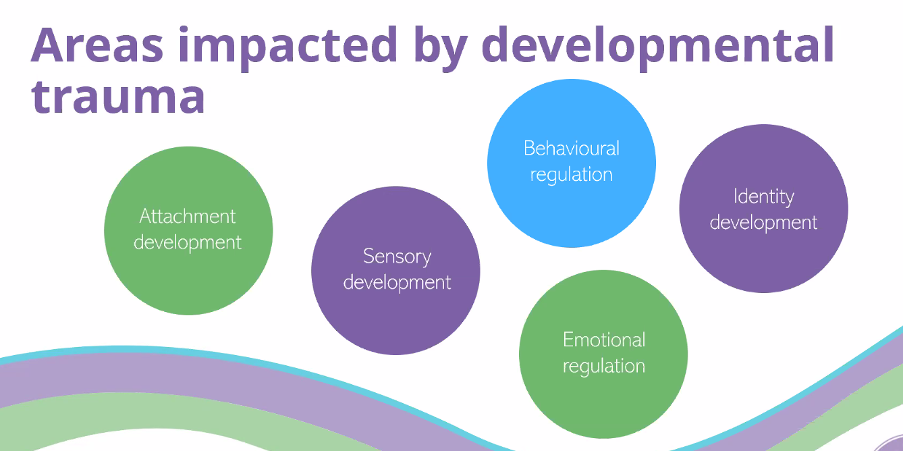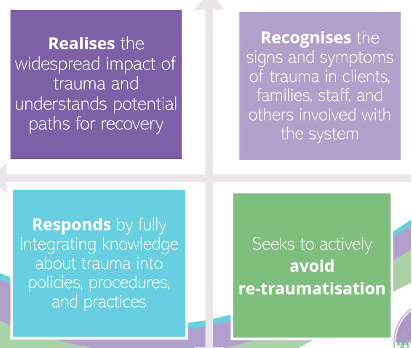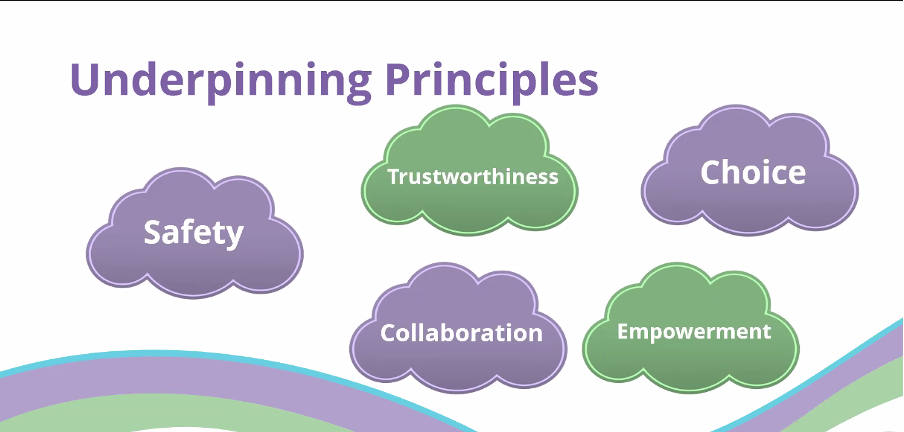HOW TRAUMA IMPACTS ON BEHAVIOUR
When a child is young, if they feel unsafe a lot of the time, it impacts on their brain development. The emotional part of their brain does not always communicate with the thinking part to enable them to accurately assess the people and environments around them. Therefore, these children can often feel under threat even when they are actually very safe, thus activating survival mode to help protect them.
This is often explained, using the ‘Window of Tolerance’.

Every child has a unique window of tolerance, based on their experiences. When within their window of tolerance (green part), they can think, learn, love, empathise; be playful, explore, reflect and use words to describe their feelings. They’re ‘at their best’. Each child has their unique triggers that push them out of this window, moving them to ‘hyperarousal ‘or ‘hypoarousal’. They can be pushed a little outside the window or a long way out.
If pushed to ‘hyperarousal’ they will go in to ‘fight, flight or freeze’ mode. Children may feel anxious, overwhelmed, frightened or even terrified and angry. Their body also changes and they may get shaky, body pains and increased heart rate.
If pushed in to ‘hypoarousal’, children will go in to ‘collapse mode’. On the outside they appear withdrawn, quiet, hard to reach, inactive and unable to learn or engage. On the inside, their heart rate decreases and their bodies get ready to feign death as a survival mode.
Children who have suffered trauma, may swing from ‘hyperarousal’ to ‘hypoarousal’ with small windows of tolerance.
As adults we need to help children expand their window of tolerance by helping them notice, communicate and manage their emotions and bring themselves back to their windows of tolerance.
We can:
*Regulate their feelings for them
*identify their triggers
*create an environment that makes them feel as safe as possible.
*Manage our own windows of tolerance to help them stay within theirs.
Stress responses can be reduced by the right support in the right place at the right time.
WHAT IS A TRAUMA INFORMED APPROACH?

There are many areas that we need to consider within a trauma informed approach.
A trauma informed approach is about understanding how traumatic events shape children or young people’s neurological development as well as other aspects such as psychological health or social behaviour patterns for example; it also involves being able to understand what types of interventions may be most helpful at different times.
Trauma informed practice is about more than just understanding or recognising trauma in individuals. It aims to increase practitioners’ awareness of how trauma can negatively impact individual children and the whole school community. This includes children and young people’s ability to feel safe and develop trusting relationships with others.
More than one in three children and young people are exposed to at least one potentially traumatic event by age 18. The right support can make a substantial difference to the extent that traumatic events impact on their lives.

A trauma informed organisation has these elements.
DEVELOPING A WHOLE SCHOOL APPROACH
Developmental trauma is complex and therefore, although any adult can make a difference by using a trauma informed lens when interacting with children, the greatest benefit to the individuals and the whole school community comes when a whole school approach is taken.
To help schools be clear on what they need to do to become trauma informed, below are some suggested components necessary for a trauma informed school:
A safe and supportive environment
This means creating an environment where children feel safe physically, psychologically, emotionally and socially. This includes having behaviour systems that have a trauma informed lens , maintaining open communication channels and providing support services for children who need it.
A trauma informed curriculum
This means incorporating trauma informed practices into the curriculum to help children understand and cope with trauma. This can be done through things like teaching about positive relationships, conflict resolution and strategies for emotional wellbeing.
A trauma informed culture
This means creating a school culture where everyone is aware of trauma and its effects, and where everyone is committed to supporting children who have experienced trauma. This includes things like training staff in trauma informed practices, raising awareness among children and parents about trauma and its effects, and being open about the support available for children and staff.
Empowerment and choice
A trauma-informed approach should empower children to make choices about their learning and participation in school activities. This includes things like allowing children to opt-out of activities that may trigger trauma, providing alternative activities for those who don’t feel ready to participate and making accommodations for children with different needs. Trauma informed schools listen to pupil voice.
HOW TO GET STARTED AS A TRAUMA INFORMED SCHOOL

Whole school benefits
It is easy to think that trauma is an issue that impacts individual children who have experienced adversity but trauma-informed practice benefits the whole school community, from children to teachers to support staff. To create a trauma-informed school, it’s important to involve everyone in the process.
School values
What does your school stand for and what kind of environment do you want to create? The underpinning principles of trauma awareness are the principles that schools would generally want to promote. It is important to consider the key principles important for your school.
Provide training in how to be trauma-informed
Staff and teachers will need to be trained in trauma-informed practices. Acumist Education can train individuals, whole staff or groups and will tailer the training to the needs of your school. We will provide practical approaches that we know work for individuals, classes and the whole school community, benefitting the wellbeing of children and staff.
Create trauma informed policies
Developing trauma-informed policies, most notably a relational, restorative approach to behaviour, are a good way to ensure that everyone in the school is aware of trauma and its effects and that everyone is committed to supporting children who have experienced trauma.
Implement trauma informed practices
Once you’ve developed trauma-informed policies and your staff have received training in trauma awareness, begin to implement trauma-informed practices in the school. This will take time and will require flexibility, resilience and continued reflection but it will be worth it.
Use a coaching approach
The underpinning principles of a coaching relationship align and support trauma-informed practice. When coaching is used to develop a trauma-informed school culture, it empowers and involves everyone in the process of becoming trauma-informed, from children and parents to teachers and support staff. This will help build buy-in and ensure that everyone is on board with the changes. Using key coaching skills such as active listening and asking coaching questions build trust, communication and relationships which are essential for being trauma informed.
Share strategies for wellbeing
Provide training for all staff on trauma and its effects, as well as trauma-informed strategies that promote wellbeing.
Creating a trauma-informed school takes time, commitment and dedication from everyone in the school community. But the benefits of doing so – for children, staff and stakeholders have a huge and lasting impact.
Contact us for more information about how we can support your school to become trauma aware and to implement trauma informed practice across the school.
